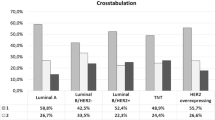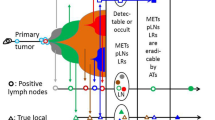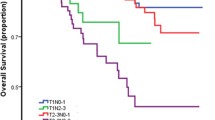Abstract
Purpose The prognosis of women with triple-negative breast cancers (defined as cancers that are estrogen receptor-negative, progesterone receptor-negative and HER2/neu negative) is poor, compared to women with other subtypes of breast cancer. It is proposed that the underlying difference in recurrence rates may be explained in part by different routes of metastatic spread. Experimental design We studied a cohort of 1608 patients diagnosed with breast cancer, diagnosed between January 1987 and December 1997 at Women’s College Hospital in Toronto. Triple-negative breast cancers were defined as those that were estrogen receptor-negative, progesterone receptor-negative and HER2/neu-negative. We compared the incidence rates of metastatic spread to bone and to other (non-bone) organs in women with triple-negative and other forms of breast cancer. Results Of the 1,608 patients, 180 (11.2%) had triple-negative breast cancer. The 1608 women were followed for a median of 9.0 years (range 0.1–19 years). Compared to other patients, those with triple-negative breast cancer had an increased likelihood of distant recurrence over the study period (adjusted hazard ratio (HR) 1.9; 95% CI: 1.5–2.5, P < 0.0001). The relatively poor prognosis was apparent in the five years after diagnosis (HR 2.9; 95% CI: 2.1–3.9; P = 0.0001) but not thereafter (HR 0.5; 95% CI: 0.2–1.1; P = 0.07). In particular, women with triple-negative breast cancer were four times more likely to experience a visceral metastasis within five years of diagnosis than those with other types of cancer (HR 4.0; 95% CI: 2.7–5.9; P < 0.0001). The rates of bone metastases were comparable for triple-negative and for other forms of cancer in this time period (HR 0.8; 95% CI: 0.4–1.6 P = 0.5). Conclusions The excess risk of distant recurrence in triple-negative breast cancers, versus other forms of cancer, is attributable in large part to an excess of visceral metastases in the first five years following diagnosis.


Similar content being viewed by others
Abbreviations
- HR:
-
Hazard ratio
- ER:
-
Estrogen receptor
- PR:
-
Progesterone receptor
- HBBC:
-
Henrietta Banting database
- CI:
-
Confidence interval
References
Perou CM, Sorlie T, Eisen MB et al (2000) Molecular portraits of human breast tumours. Nature 406:747–752. doi:10.1038/35021093
Dent R, Trudeau M, Pritchard KI et al (2007) Triple negative breast cancer. Clinical features and patterns of recurrence. Clin Cancer Res 13:4429–4434. doi:10.1158/1078-0432.CCR-06-3045
Haffty BG, Yang Q, Reiss M et al (2006) Locoregional relapse and distant metastasis in conservatively managed triple negative early-stage breast cancer. J Clin Oncol 24:5652–5657. doi:10.1200/JCO.2006.06.5664
Liedtke C, Mazouni C, Hess KR et al (2008) Response to neoadjuvant therapy and long-term survival in patients with triple-negative breast cancer. J Clin Oncol 26:1–9. doi:10.1200/JCO.2007.14.4147
Luck AA, Evans AJ, Green AR, Rakha EA, Paish C, Ellis IO (2008) The influence of basal phenotype on the metastatic pattern of breast cancer. Clin Oncol 29:40–45. doi:10.1016/j.clon.2007.10.002
Maki D, Grossman R (2000) Patterns of disease spread in metastatic breast carcinoma: influence of estrogen and progesterone receptor status. AJNR Am J Neuroradiol 21:1064–1066
Tsuda H, Takarabe T, Hasegawa T et al (2000) Large, central acellular zones indicating myoepithelial tumor differentiation in high-grade invasive ductal carcinomas as markers of predisposition to lung and brain metastases. Am J Surg Pathol 24:197–202. doi:10.1097/00000478-200002000-00005
Hicks DG, Sm Short, Prescott NL et al (2006) Breast cancers with brain metastases are more likely to be estrogen receptor negative, express the basal cytokeratin 5/6, and overexpress HER2 or EGFR. Am J Surg Pathol 30:1097–1104. doi:10.1097/01.pas.0000213306.05811.b9
Albiges L, Andre F, Balleyguier C et al (2005) Spectrum of breast cancer metastasis in BRCA1 mutation carriers; Highly increased incidence of brain metastases. Ann Oncol 16:1846–1847. doi:10.1093/annonc/mdi351
Fulford LG, Reis-Filho JS, Ryder K et al (2007) Basal-like grade III invasive ductal carcinoma of the breast: patterns of metastasis and long-term survival. Breast Cancer Res 9:R4. doi:10.1186/bcr1636
Sawka CA, Pritchard KI, Lickley HLA et al (1995) The Henriette Banting breast centre database: a model for clinical research utilizing a hospital-based inception cohort. J Clin Epidemiol 48:779–786. doi:10.1016/0895-4356(94)00176-Q
Reis-Filho JS, Tutt ANJ (2008) Triple-negative tumur, a critical review. Histopathology 52:101–118. doi:10.1111/j.1365-2559.2008.03046.x
Cheang MC, Voduc D, Bajdik C et al (2008) Basal-like breast cancer defined by five biomarkers has superior prognostic value than triple-negative phenotype. Clin Cancer Res 14:1367–1376. doi:10.1158/1078-0432.CCR-07-1658
Nielsen TO, Hsu FD, Jensen K et al (2004) Immunohistochemical and clinical characterization of the basal-like subtype of invasive berast carcinoma. Clin Cancer Res 10:5367–5374. doi:10.1158/1078-0432.CCR-04-0220
Carey LA, Perou CM, Livsay CA et al (2006) Race, breast cancer subtypes and survival in the Carolina Breast Cancer Study. JAMA 295:2492–2502. doi:10.1001/jama.295.21.2492
Bowen RL, Duffy SW, Ryan DA, Hart IR, Jones JL (2008) Early-onset breast cancer in a group of British black women. Br J Cancer 98:277–281. doi:10.1038/sj.bjc.6604174
Chukwuemeka U, Naab TJ, Mezghebe HM et al (2008) Basal cell-like (triple-negative) breast cancer, a predictor of distant metastasis in African American women. Am J Surg 195:153–158. doi:10.1016/j.amjsurg.2007.09.033
Foulkes WD, Stefansson IM, Chappuis PO et al (2003) Germline BRCA1 mutations and a basal epithelial phenotype in breast cancer. J Natl Cancer Inst 95:1482–1485
Lakhani SR, Reis Filho JS, Fulford L et al (2005) Prediction of BRCA1 status in patients with breast cancer using estrogen receptor and basal phenotype. Clin Cancer Res 11:5175–5180. doi:10.1158/1078-0432.CCR-04-2424
Ridriguez-Pinilla SM, Sarrio D, Honrado E et al (2006) Prognostic significance of basal-like phenotype and fascin expression in node-negative invasive breast cancers. Clin Cancer Res 12:1533–1539. doi:10.1158/1078-0432.CCR-05-2281
Sorle T, Perou CM, Tibshirani R et al (2001) Gene expression patterns of breast carcinomas distinguish tumor subclasses with clinical implications. Proc Natl Acad Sci USA 98:10869–10874. doi:10.1073/pnas.191367098
Sorlie T, Tibshirani R, Parker J et al (2003) Repeated observation of breast tumor subtypes in independent gene expression data sets. Proc Natl Acad Sci USA 100:8418–8423. doi:10.1073/pnas.0932692100
Sotiriou C, Neo SY, McShane LM et al (2003) Breast cancer classification and prognosis based on gene expression profiles from a population based study. Proc Natl Acad Sci USA 100:10393–10398. doi:10.1073/pnas.1732912100
Seewaldt VL, Scott V (2007) Images in clinical medicine. Rapid progression of basal-type breast cancer. N Engl J Med 356:e12. doi:10.1056/NEJMicm063760
Acknowledgments
We thank the Canadian Breast Cancer Foundation (Ontario Chapter) for support of the Henrietta Banting Data Base and Tumour Bank and for their contribution to this research.
Author information
Authors and Affiliations
Corresponding author
Rights and permissions
About this article
Cite this article
Dent, R., Hanna, W.M., Trudeau, M. et al. Pattern of metastatic spread in triple-negative breast cancer. Breast Cancer Res Treat 115, 423–428 (2009). https://doi.org/10.1007/s10549-008-0086-2
Received:
Accepted:
Published:
Issue Date:
DOI: https://doi.org/10.1007/s10549-008-0086-2




